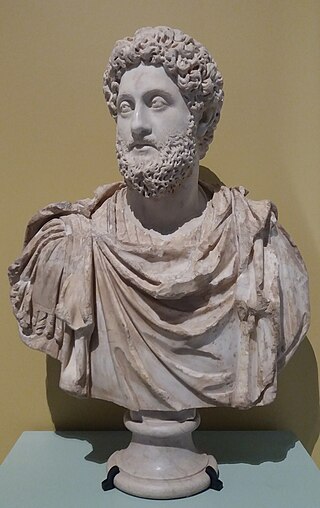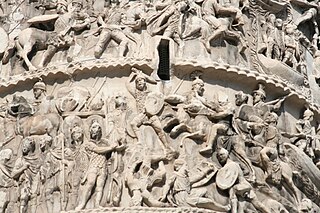Sources
- Cassius Dio, Historia romana, Book LXXII. 13
Furtius (flourished in 2nd century AD) was a ruler of the Quadi, a Germanic tribe, during the Marcomannic War.
Furtius is mentioned in the Historia romana of Cassius Dio. He had negotiated a peace treaty with Roman Emperor Marcus Aurelius. Since he considered the Quadi untrustworthy and because they were not fulfilling the conditions of the treaty, in particular with respect to the return of Roman prisoners of war, Marcus decided to invade the Quadi and destroy them completely. At this point the Quadi deposed Furtius and replaced him with Ariogaesus.

Commodus was a Roman emperor who ruled from 177 to 192. He served jointly with his father Marcus Aurelius from 177 until the latter's death in 180, and thereafter he reigned alone until his assassination. His reign is commonly thought as marking the end of a golden age of peace and prosperity in the history of the Roman Empire.

The Quadi were a Germanic people who lived approximately in the area of modern Moravia in the time of the Roman Empire. The only surviving contemporary reports about the Germanic tribe are those of the Romans, whose empire had its border on the River Danube just to the south of the Quadi. They associated the Quadi with their neighbours the Marcomanni, and described both groups as having entered the region after the Celtic Boii had left it deserted. The Quadi may later have contributed to the "Suebian" group who crossed the Rhine with the Vandals and Alans in the 406 Crossing of the Rhine, and later founded a kingdom in northwestern Iberia.

The Iazyges were an ancient Sarmatian tribe that traveled westward in c. 200 BC from Central Asia to the steppes of modern Ukraine. In c. 44 BC, they moved into modern-day Hungary and Serbia near the Dacian steppe between the Danube and Tisza rivers, where they adopted a semi-sedentary lifestyle.

Publius Helvius Pertinax was Roman emperor for the first three months of 193. He succeeded Commodus to become the first emperor during the tumultuous Year of the Five Emperors.

Marcus Didius Julianus was Roman emperor from March to June 193, during the Year of the Five Emperors. Julianus had a promising political career, governing several provinces, including Dalmatia and Germania Inferior, and defeated the Chauci and Chatti, two invading Germanic tribes. He was even appointed to the consulship in 175 along with Pertinax as a reward, before being demoted by Commodus. After this demotion, his early, promising political career languished.

Lucius Cassius Dio, also known as Dio Cassius, was a Roman historian and senator of maternal Greek origin. He published 80 volumes of the history on ancient Rome, beginning with the arrival of Aeneas in Italy. The volumes documented the subsequent founding of Rome, the formation of the Republic, and the creation of the Empire up until 229 AD. Written in Ancient Greek over 22 years, Dio's work covers approximately 1,000 years of history. Many of his 80 books have survived intact, or as fragments, providing modern scholars with a detailed perspective on Roman history.

The Buri were a Germanic tribe mentioned in the Germania of Tacitus, where they initially "close the back" of the Marcomanni and Quadi of Bohemia and Moravia. It is said that their speech and customs were like those of the Suebi. Such a statement implies that the Buri had recently come from the direction of the Baltic Sea, as other Germanic settlers in Bohemia and Moravia were newcomers, having driven out the Celtic Boii, or more likely absorbing and incorporating them after defeating them in battle and establishing a new authority. In Tacitus, the Buri are not linked to the Lugii.

The Marcomannic Wars were a series of wars lasting from about 166 until 180 AD. These wars pitted the Roman Empire against, principally, the Germanic Marcomanni and Quadi and the Sarmatian Iazyges; there were related conflicts with several other Germanic, Sarmatian and Gothic peoples along both sides of the whole length of the Roman Empire's northeastern European border, the river Danube.
Dapyx was a 1st-century BC chieftain of a Getae tribe or a tribe union in Scythia Minor. Cassius Dio talks about him in the campaigns of Marcus Licinius Crassus on the Lower Danube region, being said to be a king on the region of central Scythia Minor who went to war with Rholes, a Roman ally. Crassus came to Roles' assistance and comprehensively defeated Dapyx's army, with their leader taking refuge in a fort, being betrayed and killed.
Arnouphis or Harnouphis was an Egyptian who, according to Dio Cassius, saved the Roman legion XII Fulminata during a campaign against the Quadi in about AD 172 by calling up a rainstorm. Dio Cassius calls Arnouphis a magos, originally a term for Zoroastrian priests. David Frankfurter says that Arnouphis was an Egyptian priest, but he was called a magos because Romans regarded priests from many Near Eastern cultures as fitting a single stereotype of exotic magicians.
Genucla is the name of an ancient fortress of the Getae, located on the riverbank of the Danube or on an island on the river. It is mentioned by Dio Cassius in his History of Rome, in Book LI (51), chapter 26. The author describes the military campaign of Marcus Licinius Crassus to conquer Moesia. During this campaign he lays siege to the fortress Genucla, which was under the rule of Getaen king Zyraxes.
Rholes or Roles was a Getae chieftain in Scythia Minor mentioned by Cassius Dio in his Roman History. According to Dio, he helped Roman general Marcus Licinius Crassus defeat the Bastarnae, and when he visited Octavian, he was treated as "a friend and ally" for his support for the Romans. Later he sent for Crassus to help in his conflict with Getae chieftain Dapyx. These events have been dated to 31-27 BC.

Slovakia was partly occupied by Roman legions for a short period of time. Marcomannia was a proposed province of the Roman Empire that Emperor Marcus Aurelius planned to establish in this territory. It was inhabited by the Germanic tribes of Marcomanni and Quadi, and lay in the western parts of the modern states and Slovakia and the Czech Republic (Moravia). Part of the area was occupied by the Romans under Marcus Aurelius between 174 AD and 180 AD. His successors abandoned the project, but the people of the area became steadily Romanized during the next two centuries. The Roman influence was disrupted with the invasions of Attila starting around 434 AD and as Slavic people later began to move into the area.
Ballomar or Ballomarios was a leader of the Marcomanni during the Marcomannic Wars.
Battarius was a barbarian child ruler in the Marcomannic War. He is mentioned in the Historia romana of Cassius Dio. Accordingly, Battarius went before Marcus Aurelius, and requested an alliance. The emperor granted his request. In return for gold, Battiarus managed to succeed in restraining Tarbus, a neighbouring chieftain, who had come into Dacia threatening to make war unless Rome paid him gold.

The Gotini, who are generally equated to the Cotini in other sources, were a Gaulish tribe living during Roman times in the mountains approximately near the modern borders of the Czech Republic, Poland, and Slovakia.
Ariogaesus was a ruler of the Quadi, a Germanic tribe, during the Marcomannic War.
Publius Tarrutenius Paternus was a Roman eques who flourished during the reign of emperor Marcus Aurelius. He achieved several military successes, leading first to his appointment as praetorian prefect and subsequently to his adlection into the Roman Senate. Paternus was accused of treason by Aurelius' son and successor Commodus, and executed.
Marcus Aurelius Papirius Dionysius was a Roman eques and jurist who held a number of military and civilian positions during the reign of the Emperors Marcus Aurelius and his son Commodus, including praefectus annonae, or overseer of the grain rations for Rome.
Argentocoxos was a Caledonian chief in the early 3rd century. He is known from the Historia Romana of Cassius Dio, who gives an account of the campaigns of Septimius Severus in that region. His name means "silver leg" and shows that the Picts were Celts.